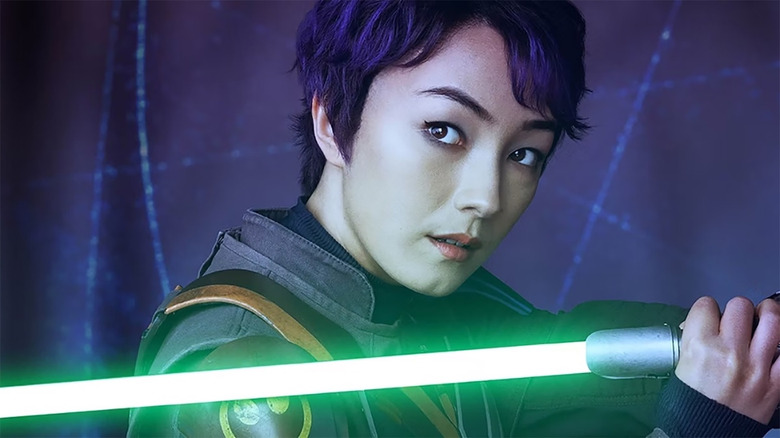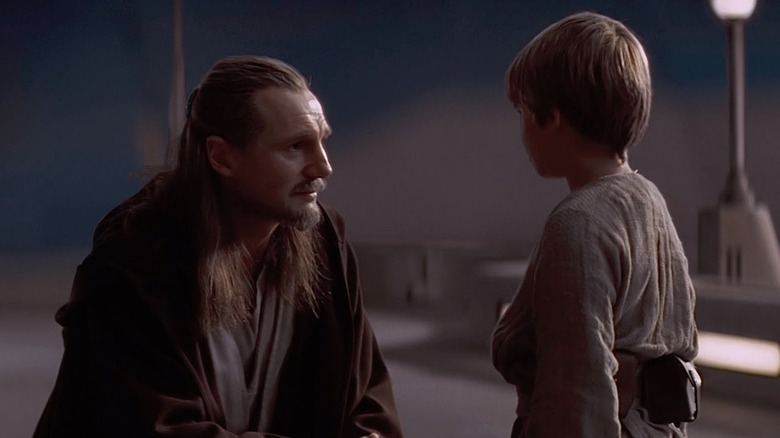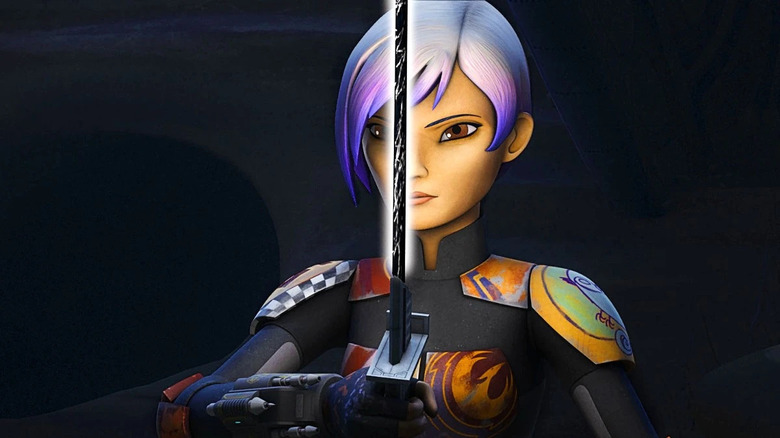Ahsoka Just Refined Some Major Star Wars Rules – Here's What It Means For The Saga
There will be spoilers for "Star Wars: Ahsoka" Chapter 1 – Master and Apprentice and Chapter 2 – Toil and Trouble.
Dave Filoni's new "Star Wars" show, "Ahsoka", picks up years after the end of "Star Wars Rebels," the animated series that ran from 2014 to 2018. "Rebels" told the story of a rebel cell led by pilot Hera Syndulla and cowboy Jedi Kanan Jarrus. Through the course of the series, they added many allies to their cadre, including former Jedi Ahsoka Tano. The show ended before the Rebels won their first victory at Scarif, but an epilogue to the show took place in the days after the victory over the Empire. Ahsoka Tano comes back to the planet Lothal to journey with Sabine Wren to the unknown parts of the galaxy to find their lost friend, Ezra Bridger.
Some thought this moment would be getting recreated in "Ahoksa," but it seems as though the scene is only echoed in these episodes. Ahsoka and Sabine clearly went on their journey and failed, though the former has continued pursuing her agenda while Sabine crawled back to Lothal. What might come as a shock to many viewers is that Ahsoka actually took Sabine, someone with no apparent aptitude for Force abilities, as her Padawan learner. How? Why?
The Force in all living things
One of the first things we ever learned about the Force is that it resides in all living things. Everything that's alive is part of the living Force. Then, in "The Phantom Menace" we learned that there's another component to it. Residing in all living cells are symbiotic lifeforms known as midi-chlorians. "Without midi-chlorians," Qui-Gon Jinn told a young Anakin Skywalker, "life could not exist and we would have no knowledge of the Force."
But when Qui-Gon tests Anakin Skywalker, he learns that his count of midi-chlorians is off the charts. Does that make it easier for him to commune with the Force? Yes. He has more latent talent and ability than someone with a low count (and everyone has at least a low count.) But does that mean people without high concentrations of midi-chlorians can't use the Force?
The answer is complicated, and Dave Filoni might be the best person to explain it, like he did in this press round table for ComicBook.com:
"To me, when you talk about the Force, the Force is in everything that's alive; that's what Obi-Wan says originally. That's true, even in the days of midi-chlorians, which everybody is afraid to talk about, but I'm not...When I was a kid, I believed that everybody probably had the Force, and they just didn't believe – midi-chlorians actually prove that theory out. We all have them, just to differing degrees."
Filoni has often described Force ability in terms of Bruce Lee's martial prowess. The executive producer said, "He has, if you like, a lot of talent for martial arts –- or a very high midi-chlorian count. If I train in martial arts, can I learn martial arts? Yes, I can improve my midi-chlorian count in that discipline. Will I be as good as Bruce Lee? No, that's not my talent."
So, can Sabine Wren train as a Jedi and improve her ability to sense these things? Yes. Will she ever be as good as the candidates that the Jedi went after when they were a large and impressive order? Probably not. In fact, Huyang, the ancient droid portrayed by David Tennant, even tells Sabine that she has less ability and aptitude in the Force than literally any Padawan he had ever seen in the Jedi Order. Harsh, but fair.
Breaking canon?
Some might argue that Sabine being trained as a Jedi breaks the canon, because she doesn't have a high midi-chlorian count or aptitude in the Force. But if you've been paying attention to the canon and the mysteries of the Force, it doesn't actually break anything. For anyone who thought midi-chlorians were the only determining factor in someone being able to become a Jedi, Dave Filoni is proving them wrong.
The bigger question is why would Ahsoka choose to train Sabine? There's a story being implied about their time together that we simply haven't seen and will need to learn more about. Sabine certainly had some aptitude, and she may have more than a little bit. Remember the episode of "Star Wars Rebels" called "Trials of the Darksaber," where Kanan Jarrus actually trains Sabine to use the Darksaber, the ancient weapon created by the first Mandalorian to become a Jedi? She was able wield it much more capably than Din Djarin was able to ever figure out in "The Mandalorian."
This does create an interesting contrast to Din Djarin, though. Where Din is trying to take a Force-strong Jedi youngling and trying to make him a Mandalorian, Ahsoka is trying to do the opposite, taking a headstrong Mandalorian and trying to make her a Jedi. In both cases, it will be fascinating to see what new abilities we'll see from these unconventional apprentices.
More luck than brains
There's a precedent, too, for characters who probably do have a higher midi-chlorian count than normal that aren't Jedi. Just look at Han Solo and Chirrut Îmwe.
Chirrut was clearly strong in the Force and could see its movements despite his physical blindness. He could also tap into it for his martial abilities. Meanwhile, Han Solo is the sort who my grandmother would say "had more luck than brains," and I would attribute that luck of Han's to another aspect of the Force. Perhaps Han had intuition about things and could pilot almost as well as Anakin Skywalker because of it.
For any characters who weren't explicit Force-users, displaying abilities of extreme luck, intuition, or a sixth sense just might be them tapping into the Force, even if they don't know it. If Sabine Wren doesn't have typical Jedi traits but still wants to train in the Force, who's to say she shouldn't? It just makes the galaxy seem a little bigger and with a lot more possibility.
New episodes of "Ahsoka" premiere on Tuesday nights on Disney+ at 9:00 PM EST.



